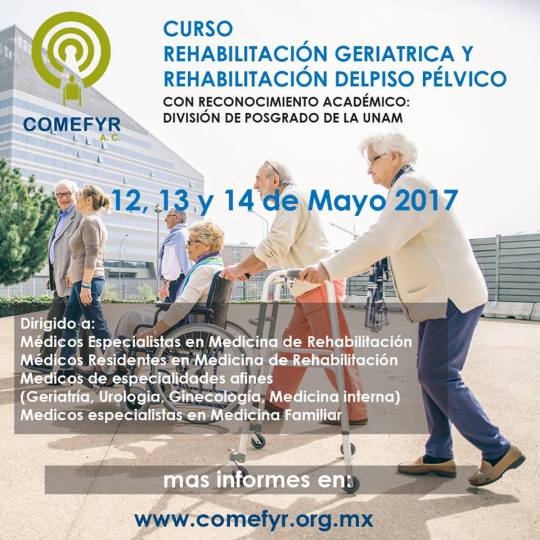Curso de Rehabilitación Geriátrica y de Piso Pélvico » Especialista en Medicina Física y Rehabilitación
·
Compartimos el temario y ponentes del Curso de Rehabilitación Geriátrica y de Piso Pélvico.
Aval: UNAM Posgrado
12-14 Mayo 2017
Límite de inscripción 26 Abril.
12-14 Mayo 2017
Límite de inscripción 26 Abril.
Viernes 12: 15:00 a 20:00h
Sábado: 09:00-18:00
Domingo: 09:00-17:30
Sábado: 09:00-18:00
Domingo: 09:00-17:30
Sede: Auditorio de la Asociación Mexicana de Contadores Públicos.
Calle Esperanza 765. Col. Narvarte.
Calle Esperanza 765. Col. Narvarte.
Dirigido a: Médicos residentes y especialistas en medicina de rehabilitación y especialidades afines (geriatría, medicina interna, medicina familiar, etc)
Costo:
$2,600 médicos especialistas
$1,800 médico residentes
$2,600 médicos especialistas
$1,800 médico residentes
____________________________________
Proceso de inscripción:
____________________________________
1. Enviar correo electrónico indicando su nombre completo y anexando escaneado:
A. título y cédula de medicina general B. Título y cédula profesional de especialidad en el caso de egresados o bien carta de asignación de médicos residentes.
Al correo: presidente@comefyr.org.mx
Proceso de inscripción:
____________________________________
1. Enviar correo electrónico indicando su nombre completo y anexando escaneado:
A. título y cédula de medicina general B. Título y cédula profesional de especialidad en el caso de egresados o bien carta de asignación de médicos residentes.
Al correo: presidente@comefyr.org.mx
2. Al enviar este mail recibirá una clave de registro así como el formato de registro a la UNAM, pudiendo realizar su pago en la modalidad que le resulte más conveniente.
3. Deberá llenar el formado de registro a la UNAM (completo y firmado) y enviar al mismo correo junto con su ficha de pago para concluir con su proceso de inscripción.
4. El trámite de inscripción enviando TODOS los documentos y ficha de pago deberán ser enviados antes del 26 de Abril. Este es un requisito indispensable para quedar inscrito en el curso ante la UNAM y poder obtener la constancia al finalizar el curso.
Anexo! ::::: >El pago podrá realizarlo en la cuenta bancaria o si desea pago con tarjeta de crédito puede realizarlo en Insurgentes sur 591 piso 4. Col. Nápoles. Frente a estación La Piedad del Metrobús (10:00 a 14:00 y de 16:30 a 19:00)



